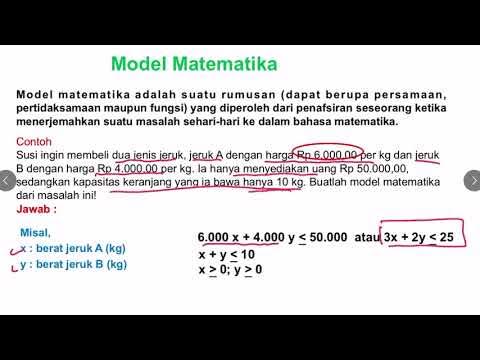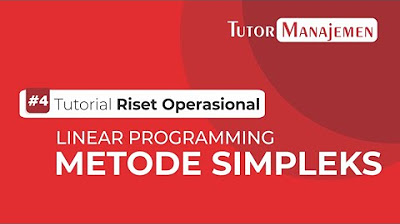Menyelesaikan Permasalahan Program Linear Menentukan Nilai Optimum dengan Metode Uji Titik Pojok
Summary
TLDRThis educational video explains the steps for solving linear programming problems with two variables, particularly in the context of word problems. It covers key concepts such as determining the mathematical model, identifying the system of inequalities, and finding the optimal solution. The lesson includes step-by-step instructions on using tables, graphing inequalities, and employing the corner-point method to solve for maximum or minimum values. The example illustrates a real-world scenario, helping viewers understand how to apply linear programming to maximize profit in a business context. The video aims to provide a clear, methodical approach to solving linear programming problems.
Takeaways
- 😀 The video explains how to solve linear programming problems in mathematics, focusing on real-world contextual problems like profit optimization.
- 😀 The key steps to solving linear programming problems are: defining the mathematical model, determining the feasible region, and finding the optimal value.
- 😀 For contextual problems, you first identify the constraints and then model them as linear inequalities.
- 😀 After defining the constraints, the next step is to graph them and identify the feasible region where all inequalities intersect.
- 😀 The objective function is crucial for determining whether to maximize or minimize the value, such as profit or cost, based on the problem's requirements.
- 😀 There are two main methods for finding the optimal solution: the corner point method and the line test method. The video focuses on the corner point method.
- 😀 The first step is to define the system of inequalities (constraints) and the objective function using a table of relevant data.
- 😀 For the example problem, constraints like the total number of vehicles and total budget were translated into linear inequalities.
- 😀 Graphing the constraints involves testing points (like 0,0) to determine which side of the inequality the feasible region lies on.
- 😀 Once the feasible region is identified, the next step is to find the corner points (vertices) and substitute them into the objective function to find the optimal value.
- 😀 The final result in the example shows the maximum profit that can be obtained by determining the optimal number of each type of vehicle to sell.
Q & A
What is the main focus of the video?
-The video focuses on solving linear programming problems, specifically those involving two variables, and covers the steps to determine optimal values in real-world scenarios.
What are the key points discussed in the video?
-The video discusses three main points: 1) determining the solution region of a linear inequality system, 2) forming a linear inequality system from a given solution region, and 3) solving linear programming problems using contextual problems.
What is the first step when solving linear programming problems?
-The first step is to identify and write the mathematical model, which includes determining the linear inequality system and the objective function.
How is the objective function used in linear programming?
-The objective function is typically used to calculate either the maximum or minimum value of a certain quantity, such as profit or cost, based on the values of the variables in the system.
What is the method discussed for solving linear programming problems?
-The method discussed is the 'corner-point test,' which involves identifying the coordinates of the corner points of the feasible region and evaluating the objective function at these points.
What was the context of the example problem provided in the video?
-The example problem involves a motor dealership, where the objective is to maximize the profit from selling two types of motors, given the prices, costs, and the dealership’s budget.
What steps are involved in solving the example problem?
-The steps include: 1) defining the variables and constraints, 2) setting up the linear inequalities based on the problem’s conditions, 3) graphing the inequalities, 4) determining the feasible region, and 5) evaluating the objective function at the corner points.
What role do the corner points play in solving the linear programming problem?
-The corner points, or vertices, of the feasible region are crucial as they represent potential solutions. The optimal value of the objective function is found by evaluating it at each corner point.
Why is it important to eliminate negative values in the context of linear programming?
-Negative values are not feasible in this context, as the solution represents a real-world scenario (e.g., the number of motors), where negative quantities do not make sense. This is why we restrict the solution to the first quadrant of the coordinate plane.
How is the optimal solution determined after finding the corner points?
-The optimal solution is determined by substituting the coordinates of each corner point into the objective function and identifying which point gives the maximum or minimum value, depending on the goal of the problem (e.g., maximum profit).
Outlines

This section is available to paid users only. Please upgrade to access this part.
Upgrade NowMindmap

This section is available to paid users only. Please upgrade to access this part.
Upgrade NowKeywords

This section is available to paid users only. Please upgrade to access this part.
Upgrade NowHighlights

This section is available to paid users only. Please upgrade to access this part.
Upgrade NowTranscripts

This section is available to paid users only. Please upgrade to access this part.
Upgrade NowBrowse More Related Video

MENENTUKAN MODEL MATEMATIKA DARI SOAL CERITA SPtLDV

ART TEACHES MATHEMATICS IN THE MODERN WORLD-LESSON 1: INTRO TO LINEAR PROGRAMMING

Membuat Model Matematika Sistem Persamaan Linear Dua Variabel

Linear Programming dengan Metode Grafik

Riset Operasi #4 - Linear Programming dengan Metode Simpleks | Tutor Manajemen by Gusstiawan Raimanu

PERSAMAAN LINEAR SATU VARIABEL - MATEMATIKA KELAS 7
5.0 / 5 (0 votes)